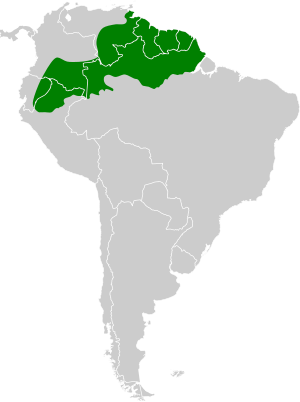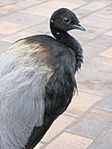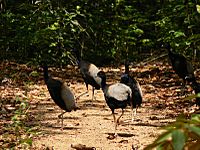Grey-winged trumpeter facts for kids
Quick facts for kids Grey-winged trumpeter |
|
|---|---|
| [[File:Grey-winged fiver
crepitans Side 1700px.jpg|frameless|upright=1]] |
|
| At the US National Aviary | |
| Conservation status | |
| Scientific classification | |
| Genus: |
Psophia
|
| Species: |
crepitans
|
 |
|
The grey-winged trumpeter (Psophia crepitans) is a special kind of bird. It belongs to a small family of birds called Psophiidae. You can find these birds in parts of South America, including Brazil, Colombia, Ecuador, French Guiana, Guyana, Peru, Suriname, and Venezuela.
Contents
About Its Name
Scientists group animals together based on how they are related. For the grey-winged trumpeter, it's a bit tricky! Different groups of scientists have slightly different ideas about how to classify it.
Most groups agree that there are three main types, or "subspecies," of the grey-winged trumpeter. These are P. c. crepitans, P. c. napensis, and P. c. ochroptera. However, some experts think that P. c. ochroptera might be its own separate species, or even a type of pale-winged trumpeter. It's like how different families might have different ways of organizing their photo albums! For this article, we'll stick to the idea that there are three subspecies.
What It Looks Like
The grey-winged trumpeter looks a bit like a chicken, but with a long neck and long legs. It also has a slightly humped back. These birds are about 45 to 52 centimeters (18 to 20 inches) long.
Both male and female trumpeters look similar. Their strong beaks are a yellowish-green color and curve down a little. Their legs and feet are greenish-olive. Most of their feathers are black.
Different subspecies have slight differences in their colors:
- The P. c. crepitans subspecies has shiny green or violet feathers on its lower neck. Its inner wings and rump (the lower back) are a dusty gray, and the middle of its back is a yellowish-brown to reddish-brown.
- The P. c. napensis subspecies has a bronze or purple shine on its feathers, lighter gray wings and rump, and a more reddish-brown back.
- The P. c. ochroptera subspecies has wings, rump, and middle back that are completely yellowish-brown.
Where It Lives and Its Home
The grey-winged trumpeter lives in the northern part of the Amazon Basin. This is a huge area of rainforest in South America.
- The P. c. crepitans subspecies lives from southeastern Colombia, across eastern and southern Venezuela, through the Guianas, and south into Brazil.
- The P. c. ochroptera subspecies is found in northwestern Brazil.
- The P. c. napensis subspecies lives from southeastern Colombia, south through eastern Ecuador, into northeastern Peru, and a small part of northwestern Brazil.
These birds prefer to live in thick, lowland tropical rainforests. They like areas that are far away from people and have an open space under the trees with many fruit-bearing trees. Even though they mostly live in low areas, they can sometimes be found in higher cloudforests.
How It Behaves
Grey-winged trumpeters are very social birds. They live in groups, or "flocks," of up to about 15 birds. These flocks include birds of all ages. Each group has its own territory, which can be quite large, sometimes as big as 85 hectares (210 acres).
Movement
These birds don't migrate, meaning they don't travel long distances. They usually stay within their flock's territory. They also don't cross large rivers.
Feeding
Adult grey-winged trumpeters mostly eat soft fruits that have fallen to the forest floor. Many of these fruits are knocked down by animals like squirrel monkeys or other birds. The trumpeters don't need to follow monkey groups because there's usually enough fruit on the ground. They mostly eat fruit from large trees, but they will also pick fruit from smaller bushes.
About 10% of their diet is made up of small insects and other tiny creatures, called arthropods. Sometimes, they follow army ant swarms to catch these small creatures. Baby trumpeters eat more arthropods when they are young. Adults also sometimes eat small animals with backbones, but this is rare.
Reproduction and Life Cycle
Grey-winged trumpeters have an interesting way of raising their young. They are "polyandrous," which means one female mates with several males. They are also "cooperative breeders," meaning all members of the flock help raise the young birds. Up to three males might mate with the main female in the group.
These birds usually make their nests in holes in trees that other animals have made, or in natural cracks in tree trunks. They don't build a nest inside the hole. They seem to time their breeding so that their eggs hatch when there is plenty of fruit and insects available, usually at the start of the rainy season. A female usually lays three eggs, but sometimes two or four.
Vocalization
All trumpeter birds are known for being very noisy! The grey-winged trumpeter's song is a low, humming sound like "wuh-wuh-wuh wuh wuh - -". When they sense danger, their alarm call is a loud, harsh "GRAH" sound.
In Captivity
People in the areas where trumpeters live sometimes tame them. They use them as "sentinels" or guards because these birds are very good at spotting predators and making loud alarm calls. People also believe that trumpeters can kill snakes.
A famous grey-winged trumpeter named Trumpy lived at Jersey Zoo. The author Gerald Durrell kept him there. Trumpy was known for being friendly and interacting with the people and other animals at the zoo. Gerald Durrell even wrote about Trumpy several times in his book "Menagerie Manor".
Status in the Wild
The IUCN (International Union for Conservation of Nature), which tracks how endangered animals are, considers the grey-winged trumpeter to be of "Least Concern." This means that, for now, there are still many of them in the wild, and they are not in immediate danger of disappearing.
However, their numbers are believed to be decreasing. These birds are often hunted by people. They are also frequently trapped by local communities, but they don't reproduce well when kept in captivity. Another big threat is the loss of their forest home due to deforestation for timber, cattle ranching, and gold mining.
Gallery
See also
 In Spanish: Trompetero aligrís para niños
In Spanish: Trompetero aligrís para niños






